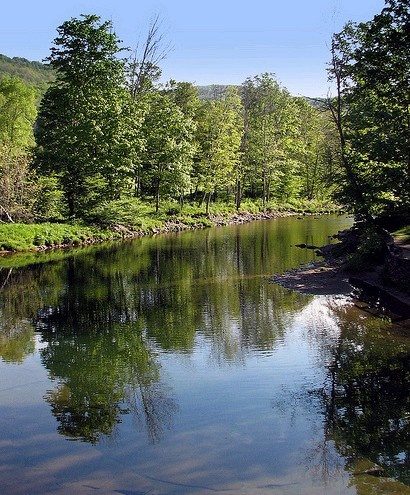Beaver Kill Fishing Spot
- Acreage: 238
- Elevation: 1578'
- Last Modified By: vinny60 on 09/07/09 01:29 PM
- Ask about Beaver Kill in our Fishing Forums
Photos
Fish Species
Beaver Kill Description
The Beaver Kill is a tributary of the East Branch of the Delaware River, approximately 44 miles (71 km) long, in the U.S. State of New York. The kill runs through the Catskill Mountains and has long been celebrated as one of the most famous trout streams in the United States. Its preservation helped establish many of the basic conservation principles of rivers in the United States. The river has been popular as a trout stream since the early 19th century, when it became one of the first resort destinations in the United States. The subsequent depletion of the brook trout population by the 1850s led to an early conservation movement to preserve the river, including the introduction of hatcheries for brown trout. Its popularity as a trout stream arises in part from the many cold springs and deep pools in the upper river that keep the water at an even cold temperature. The fly fishing industry is centered around Roscoe, home to several fly-shops and bed and breakfasts catering to fishermen from around the world. More local fly fishing history and information can be found at the Catskill Fly Fishing Center and Museum located in Livingston Manor. The upper 27 miles of the river are known as the Upper Beaverkill. This part of the river is narrow, steep, and very rocky. The first five miles are from 5 to 25 feet wide. This section consists of small pools and pocket water. The Upper Beaverkill is well shaded and has many cold springs, which keep its deep bedrock pools cold all year round. The next stretch of the upper part is from the Balsam Lake outlet down to Shin Creek at Lew Beach. This 12-mile stretch is from 20 to 60 feet wide. Here, there are more medium-sized pools that are separated by shallow riffle sections. Jones Falls is the most prominent feature in this section of the river. It is located about two miles above Turnwood, where it plunges 30 to 40 feet into a deep pool. CLICK FOR MAP The 11-mile stretch from Lew Beach to Junction Pool continues to grow in size. The river widens from 50 to 75 feet, with the pools and riffles becoming longer and more pronounced. The Covered Bridge Pool, at the state campsite, is located in this section. The lower section of the Beaverkill begins at the famous Junction Pool, where the Beaverkill and the Willowemoc join. Here, the river almost doubles in size, which is why it is known as "Big River." This pool became famous because it unites two of the Northeast's most famous trout streams. The water in this section of the river is made up of beautiful riffles and pools that cater to the dry-fly fisherman. The Beaverkill's two-mile no-kill section, which begins at the Delaware County line, is also part of this section of the river. Horse Brook Run and Carin's Pool are both famous sections of the Beaverkill's no-kill water. Horse Brook Run is regarded by most as 1/4 mile of the finest pocket of water on the river. This section can be very difficult to wade, so fishermen must be careful. Carin's Pool is a long, deep, clear pool that holds a tremendous number of fish. This pool and its fishermen are visible from one of the overpasses on Route 17. The last 10 miles of the Beaverkill are made up of long, shallow riffles and pools. Painters' Bend, Cooks Falls Pool, and the Flats are popular areas to fish in this section. About nine miles below the Cooks Falls Pool is the Horton no-kill section, which contains some excellent trout water. Stadel's Run, Cemetery Pool, Freeman's Flat, Horton's Pool, Acid Factory and Railroad Run all fish well when the water temperatures are good. Below the Horton no-kill section, the remaining six miles of the river are wide, and a slow-moving, shallow section of water. The only exception is where Trout Brook joins the river. The Beaverkill ends at Keener's Pool, which is known for its large trout. The beautiful water, numbers of trout, and excellent hatches have made the Beaverkill a legend that most fishermen have heard of, and that all fly fishermen should experience.
The Beaver Kill is a tributary of the East Branch of the Delaware River, approximately 44 miles (71 km) long, in the U.S. State of New York. The kill runs through the Catskill Mountains and has long been celebrated as one of the most famous trout streams in the United States. Its preservation helped establish many of the basic conservation principles of rivers in the United States.
